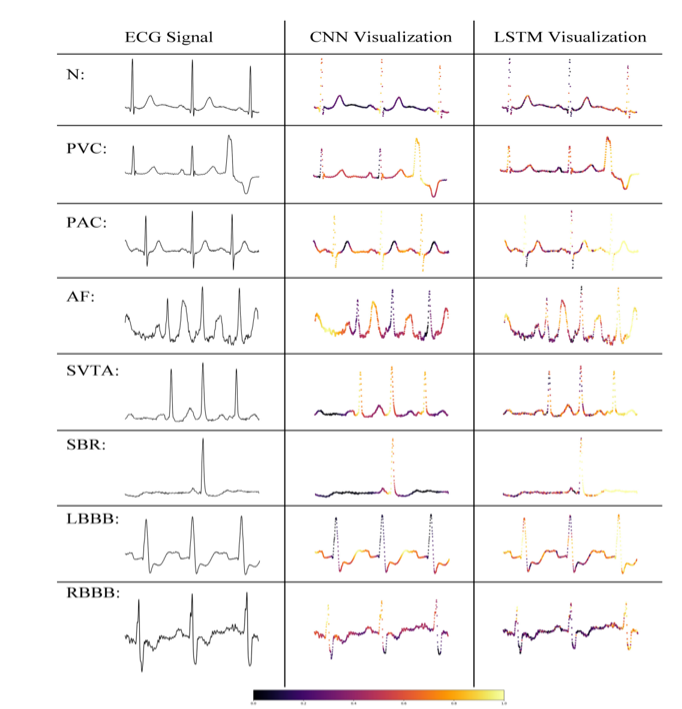Interpretable Deep Neural Network for Single-Lead ECG Arrhythmia Classification
 Cardiac arrhythmia is a prevalent and significant cause of morbidity and mortality among cardiac ailments. Early diagnosis is crucial to provide intervention for patients suffering from cardiac arrhythmia. Traditionally diagnosis is performed by examination of the Electrocardiogram (ECG) by a cardiologist. This method of diagnosis, however, is hampered by the subjectivity and limited access to cardiologists. To this end, we propose a novel network consisting of a convolutional neural network (CNN) and long short-term memory network (LSTM) for automated classification of a 2-second single lead ECG rhythm into one of the 8 heart rhythms comprising of 7 different arrhythmia. The performance of the proposed 8 class classification network is compared with implementations of two state-of-the-art models for the same task. An additional benchmark of the proposed network is obtained using the standard Advancement of Medical Instrumentation (AAMI) recommended arrhythmia grouping applied to the MIT-BIH dataset. We report significant improvements over the state-of-the-art on both evaluation methods, obtaining accuracies of 0.97 for 8-class classification and 0.99 for the AAMI grouped 4-class classification. Two methods are proposed to provide interpretability to the models. The first method is a novel application of Gradient-weighted Class Activation Map (Grad-CAM) for visualizing the saliency of the CNN model. In the second approach, saliency is derived by learning the input deletion mask for the LSTM model. The results of model saliency not only provide insight into the prediction capability of the model but also aligns with the medical literature for the classification of cardiac arrhythmia.
Cardiac arrhythmia is a prevalent and significant cause of morbidity and mortality among cardiac ailments. Early diagnosis is crucial to provide intervention for patients suffering from cardiac arrhythmia. Traditionally diagnosis is performed by examination of the Electrocardiogram (ECG) by a cardiologist. This method of diagnosis, however, is hampered by the subjectivity and limited access to cardiologists. To this end, we propose a novel network consisting of a convolutional neural network (CNN) and long short-term memory network (LSTM) for automated classification of a 2-second single lead ECG rhythm into one of the 8 heart rhythms comprising of 7 different arrhythmia. The performance of the proposed 8 class classification network is compared with implementations of two state-of-the-art models for the same task. An additional benchmark of the proposed network is obtained using the standard Advancement of Medical Instrumentation (AAMI) recommended arrhythmia grouping applied to the MIT-BIH dataset. We report significant improvements over the state-of-the-art on both evaluation methods, obtaining accuracies of 0.97 for 8-class classification and 0.99 for the AAMI grouped 4-class classification. Two methods are proposed to provide interpretability to the models. The first method is a novel application of Gradient-weighted Class Activation Map (Grad-CAM) for visualizing the saliency of the CNN model. In the second approach, saliency is derived by learning the input deletion mask for the LSTM model. The results of model saliency not only provide insight into the prediction capability of the model but also aligns with the medical literature for the classification of cardiac arrhythmia.
This work is submitted at NeurIPS ML4H 2019.